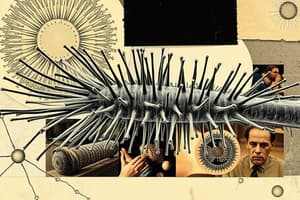Podcast
Questions and Answers
What is the primary function of flagellar movement?
What is the primary function of flagellar movement?
- Aiding in spermatozoa swimming (correct)
- Enhancing excitability in muscles
- Assisting in body postures
- Supporting muscle contraction
What is a key characteristic of visceral muscles?
What is a key characteristic of visceral muscles?
- Location in skeletal components
- Striation under the microscope
- Voluntary control by the nervous system
- Smooth appearance (correct)
What are the special properties of muscles?
What are the special properties of muscles?
- Excitability, contractility, extensibility, elasticity (correct)
- Ductility, conductivity, density, viscosity
- Transparency, rigidity, flexibility, durability
- Opacity, fragility, compressibility, brittleness
Which type of muscle is closely associated with the skeletal components of the body?
Which type of muscle is closely associated with the skeletal components of the body?
Why are skeletal muscles also known as voluntary muscles?
Why are skeletal muscles also known as voluntary muscles?
In which type of muscle are activities not under voluntary control of the nervous system?
In which type of muscle are activities not under voluntary control of the nervous system?
What is the appearance of smooth muscles under a microscope?
What is the appearance of smooth muscles under a microscope?
What is the origin of muscle tissue?
What is the origin of muscle tissue?
What is the primary function of skeletal muscles?
What is the primary function of skeletal muscles?
What distinguishes cardiac muscles from skeletal and smooth muscles?
What distinguishes cardiac muscles from skeletal and smooth muscles?
Study Notes
Cell Projections
- Cilia and flagella are outgrowths of the cell membrane
- Flagellar movement helps in:
- Swimming of spermatozoa
- Maintenance of water current in the canal system of sponges
- Locomotion of Protozoans like Euglena
Muscle Tissue
- Originates from mesoderm
- Comprises 40-50% of adult human body weight
- Special properties:
- Excitability
- Contractility
- Extensibility
- Elasticity
Classification of Muscles
- Based on location:
- Skeletal muscles
- Visceral muscles
- Cardiac muscles
Skeletal Muscles
- Associated with skeletal components of the body
- Striped appearance under microscope (striated muscles)
- Voluntary muscles (under nervous system control)
- Involved in:
- Locomotory actions
- Changes of body postures
Visceral Muscles
- Located in inner walls of hollow visceral organs (e.g. alimentary canal, reproductive tract)
- Smooth appearance (non-striated muscle)
- Involuntary muscles (not under nervous system control)
Studying That Suits You
Use AI to generate personalized quizzes and flashcards to suit your learning preferences.
Description
Test your knowledge on the topics of cilia, flagella, and muscles. Learn about the functions of cilia and flagella in various organisms, as well as the unique properties of muscle tissues.




